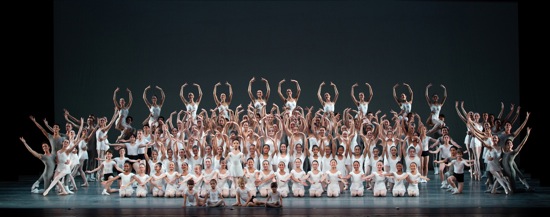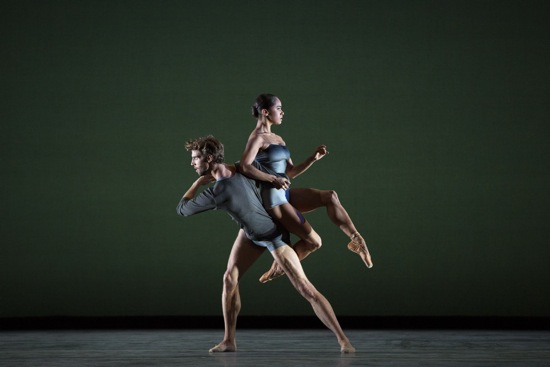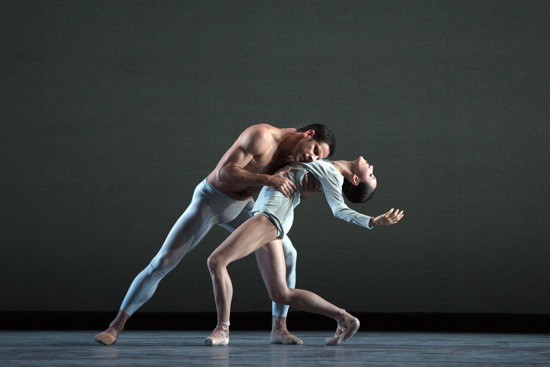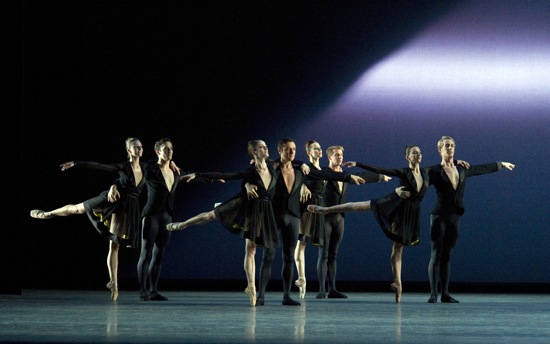American Ballet Theatre’s fall season begins its 75th anniversary celebration.

Students from the American Ballet Theatre Jacqueline Kennedy Onassis School in the final tableau of Alexei Ratmansky’s Rondo Capriccioso. Photo: Marty Sohl
It’s traditional at anniversary celebrations to raise a glass to the past and speculate optimistically about the future. For American Ballet Theatre, with 80 dancers to be paid (along with the necessary artistic and business-oriented staff members) an excuse for a fund-raising gala is a godsend. Its 2014 and 2015 New York seasons can be tied to two anniversaries: the company’s 75th and the tenth for the American Ballet Theatre Jacqueline Kennedy Onassis School.
During ABT’s fall season at Lincoln Center (October 22-November 2), two masterworks commissioned or acquired in the 1940s are on view: Jerome Robbins’s Fancy Free and Antony Tudor’s Jardin aux Lilas. Plus Twyla Tharp’s Bach Partita (1983). The Opening Night Gala, however, did not focus on the distant past. Instead, the future was represented by Artist in Residence Alexei Ratmansky’s display of hordes of students at the above-mentioned school, the recent past by Christopher Wheeldon’s Thirteen Diversions, and the immediate present (plus, maybe, its future) by Liam Scarlett’s brand new With a Chance of Rain.
I don’t even want to think about how Ratmansky and his assistants at the ABT JKO School managed in Rondo Capriccioso to coordinate, with sparkling theatrical elan, the maneuvers of platoons of young dancers, ranging from one consisting of five company apprentices down through numerous more sizeable groups, in descending order of age and expertise, to four Primary and Pre-Primary toddlers (whose main business it was to be adorable and to enter, run, and sit at the appropriate moments). The miracle is that Ratmansky, working with music by Camille Saint-Saëns (“Introduction and Rondo Capriccioso”), didn’t simply showcase the various levels of very adroit, finely trained young dancers; he made a real ballet by skillfully interweaving and layering the ten (!) units in beguiling formations and with come-and-go dynamic contrasts.
Rondo Capriccioso (with Benjamin Bowman as violin soloist and Ormsby Williams conducting the orchestra) began with a charming caprice that referred to Etudes, a 1948 ballet by Danish choreographer Harald Lander (often performed by ABT) that was designed to show off dancerly training and virtuosity. In it, Lander recreated ballet history in a vignette filched from August Bournonville’s 1856 La Ventana. For Rondo Capriccioso, Ratmansky, who spent several years dancing in Bournonville’s works as a member of the Royal Danish Ballet has referenced the same bit of stage trickery. In his ballet, it’s a demure little girl who practices a few steps in front of a tall mirror. When she turns to face it, she acquires (surprise!) a reflection (an equally adroit young dancer). Ratmansky adds another illusion: to the amazement of the child in front of the mirror, her “reflection” soars beautifully and floats in mid-air (a nearly invisible, black-covered adult dancer manages the trick).

ABT’s James Whiteside and Misty Copeland in Liam Scarlett’s With a Chance of Rain. Photo: Marty Sohl
Liam Scarlett, who got his start as a dancer in England’s Royal Ballet—first in its school, then in its company—was still a student when he began to choreograph. Given the relative paucity of up-and-coming ballet choreographers, he is in demand, hot—very hot, very busy. I am in no doubt as to his expertise in creating interesting steps nor to his imagination. But I’m still trying to figure him out.
I’m not surprised to discover that he created for the Royal Ballet a Hansel and Gretel with a “dark and unique twist” (ABT press kit) or that he drew on Jack the Ripper cases for another ballet. The title of his new work, With a Chance of Rain, suggests that fair weather is uncertain from the start. Setting it to seven preludes by Sergei Rachmaninoff (masterfully played from the pit by pianist Emily Wong) gave Scarlett plenty of backup for shifting moods. What’s going on among his cast of eight is something of a mystery. They begin facing away from us as separated silhouettes against a not very bright sky, They’re slumping a bit; then one man (Marcelo Gomes, I believe) straightens up and starts moving his arms sinuously. The others wake up. If I were to try to nail this ballet down, I’d say it’s about the failure of wayward pas de deux to produce a satisfactory life style, even though that’s the goal. The eight terrific individuals are paired in the program: Hee Seo and Gomes, Misty Copeland and James Whiteside, Gemma Bond and Joseph Gorak, Devon Teuscher and Sterling Baca.
What stands out in my memory are not dance steps (although there’s a sufficiency of these), but intimate tanglings, forlorn still moments, a welcome subversion of conventional gender roles (men jump into women’s arms at one point; Gomes and Whiteside support each other in a duet, while Seo and Copeland sit and watch them), and a startlingly tacky vignette that occurs twice. This last makes its first appearance when, after a duet full of sharp changes of directions and steps, Copeland stands front and center and puts her hands behind her head so that Whiteside can burrow his head into her stomach and wiggle it, as if he were a bee excited by honey. The next time, he wiggles his butt instead and places his hands briefly on her breasts; she leaves, and, in shadowed lighting by the excellent Brad Fields, Gomes, bare-chested. takes Copeland’s place. Whiteside appears not to notice the change of partner; when he does (did I really see this?), he reaches up and tweaks Gomes’s nipples.
These diversions have no apparent repercussions. Nor do Bond and Teuscher exhibit anger when their partners drop them to the floor with an audible thump and hurry to join another dance. Bond often has rather a hard time. Copeland takes, Gorak, her colleague’s partner, away with her. Gomes enters paying the now-solitary Bond no mind, just doing his handsome thing, but when Seo wanders in dreamily, he embraces the new arrival; he dances wonderfully, expansively, and briefly, but she leaves. Bond looks hopeful, but Gomes gives her a brotherly kiss on the cheek and exits. She’s alone again. Gorak re-enters, as does Seo. And so it goes. I have no idea why Baca lays Teuscher out on the floor, where she remains for a while.
The next encounter for Gomes and Seo is slow and hot. He embraces and manipulates her in such a way that he keeps his body—and sometimes his face—as close to her as possible. You imagine him whispering, “See what I can do with you?” Or: “Does this feel as good to you as it does to me?”
In putting this program together, artistic director Kevin McKenzie clearly considered the theme of legacies and moving forward. He wanted to show off a good number of his sterling dancers. But he forgot about a possible pas de deux epidemic. A fine pas de deux can be a metaphor for loving support and tenderness, for shared rapture, for a test of skills. But if you see a lot of ballet duets in one evening—especially ones with crazy lifts and tangling limbs and men gazing adoringly past the crotches they’ve just revealed by pulling a woman’s legs apart—you can feel that the form has gotten a little out of hand. If a man really adores a woman, would he want to hold her overhead on one straight arm like a show-off waiter with a roast of beef? (I know, I know. . . .Many of you out there will want to dispute that image on a number of grounds, but still. . . .)
So I’m beginning to feel a slight pas de deux alert when Christopher Wheeldon’s Thirteen Diversions (premiered by ABT in 2011) is about to begin and I notice that this ballet too features four principal male-female couples and eight secondary ones. Also that Benjamin Britten’s accompanying “Diversions for Piano (left hand) and Orchestra” (with Charles Barker as the conductor and Barbara Bilach as the soloist) consists of a theme, ten variations, and a finale. The music embraces fierceness, sweetness, harshness, playfulness, circus fanfares, rhythmic emphasis; there’s a march, a nocturne, and a tarantella. A plague of pas de deux could ensue.
Wheeldon is too smart and too skillful for that. He mixes and stirs and supplants the sixteen dancers in black with the eight principal ones in pale gray ((the handsome costumes are by Bob Crowley) Thirteen Diversions is a splendid ballet, briskly classical, full of kaleidoscopic formations that transform and dissolve, contrapuntal flurries, and all manner of finely shaped phrases of dancing. Field’s lighting plays an important role in the constantly (but not nervously) changing stage picture. In the beginning, a beam of light from the wings creeps up one side of the cyclorama to create a right-angled triangle. This gradually changes color, according to the musical and choreographic temperature, becomes a horizontal ray, and, at one point, silhouettes the pairs in black against a wash of orange-gold.
Wheeldon provides strictly classical steps, sometimes eased around the seams. For instance, executing pirouette after pirouette while travelling, the dancers end each turn by whipping their bodies off the usual verticality as they begin the plunge into the next spin. The four fine principal pairs are Sarah Lane and Craig Salstein, Isabella Boylston and Cory Stearns, Gillian Murphy and Thomas Forster, Christine Shevchenko and Blaine Hoven. The duets that crop up, almost informally, among these vary in timing and setting and how they are isolated from, or shadowed by, the pairs in black. The one for Boylston and Stearns is the most private; they’re alone in their own bright glow in a dark space. Boylston uses her legs in wonderfully extravagant (but not flashy) ways, giving the impression that they begin somewhere around her waist. Their rendezvous was only marred (for me) by the maneuver that ended with Stearns turning Boylston upside down. Why would any man want to do that? What woman today would put up with it?
Never mind my crabbiness. The ballet is a beauty, the dancers are superb, and glimpses of the crowd staying for the post-performance dinner indicated that women who wear gowns this expensive can well afford to help fund a very, very deserving ballet company that boasts an impressive past and looks toward a possibly adventurous future.


